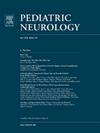儿童和青少年抽动的前兆冲动:测量、描述和关联。
IF 3.2
3区 医学
Q2 CLINICAL NEUROLOGY
引用次数: 0
摘要
背景:本研究旨在探讨抽动障碍儿童的先兆冲动,以描述这些冲动与各种因素的关系。方法:招募首发和初治TDs患者。我们进行了一项综合研究,利用抽搐前兆冲动量表来衡量脓肿的严重程度。通过回归分析,探讨脓肿与人口统计学特征、抽动严重程度、合并症等相关因素的关系。结果:线性回归模型显示,年龄(β = 0.090, P = 0.004)、运动抽动严重程度(β = 0.112, P)与TD患儿脓肿的性质有关。未来的研究应侧重于不同年龄组的脓包,并开发和评估旨在减轻抽搐严重程度的靶向治疗方法。本文章由计算机程序翻译,如有差异,请以英文原文为准。
The Premonitory Urge to Tic in Children and Adolescents: Measuring, Describing, and Correlating
Background
This study aimed to explore the premonitory urges (PUs) experienced by children with tic disorders (TDs), with the aim of describing and correlating these urges with various factors.
Methods
First-episode and drug-naive patients with TDs were recruited. We conducted a comprehensive study utilizing the Premonitory Urge for Tics Scale to measure the severity of PUs. Regression analysis was performed to explore the relationships between PUs and other relevant factors, such as demographic characteristics, tic severity, and comorbidities.
Results
The linear regression model revealed that age (β = 0.090, P = 0.004), the severity of motor tics (β = 0.112, P < 0.001), the severity of vocal tics (β = 0.074, P = 0.020), and the severity of tic-related impairments (β = 0.112, P = 0.001) were significant predictors of PUs.
Conclusions
This study provides insights into the nature of PUs in children with TD. Future research should focus on PUs across different age groups and develop and evaluate targeted treatments that aim to reduce the severity of tics.
求助全文
通过发布文献求助,成功后即可免费获取论文全文。
去求助
来源期刊

Pediatric neurology
医学-临床神经学
CiteScore
4.80
自引率
2.60%
发文量
176
审稿时长
78 days
期刊介绍:
Pediatric Neurology publishes timely peer-reviewed clinical and research articles covering all aspects of the developing nervous system.
Pediatric Neurology features up-to-the-minute publication of the latest advances in the diagnosis, management, and treatment of pediatric neurologic disorders. The journal''s editor, E. Steve Roach, in conjunction with the team of Associate Editors, heads an internationally recognized editorial board, ensuring the most authoritative and extensive coverage of the field. Among the topics covered are: epilepsy, mitochondrial diseases, congenital malformations, chromosomopathies, peripheral neuropathies, perinatal and childhood stroke, cerebral palsy, as well as other diseases affecting the developing nervous system.
 求助内容:
求助内容: 应助结果提醒方式:
应助结果提醒方式:


